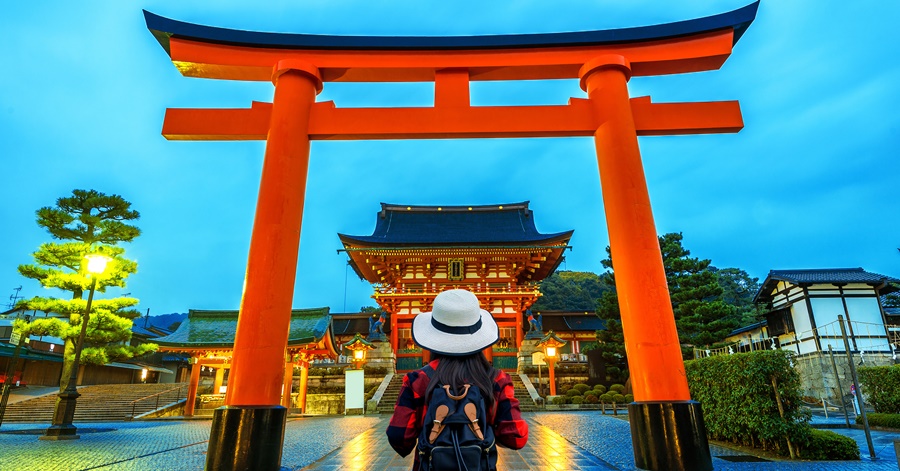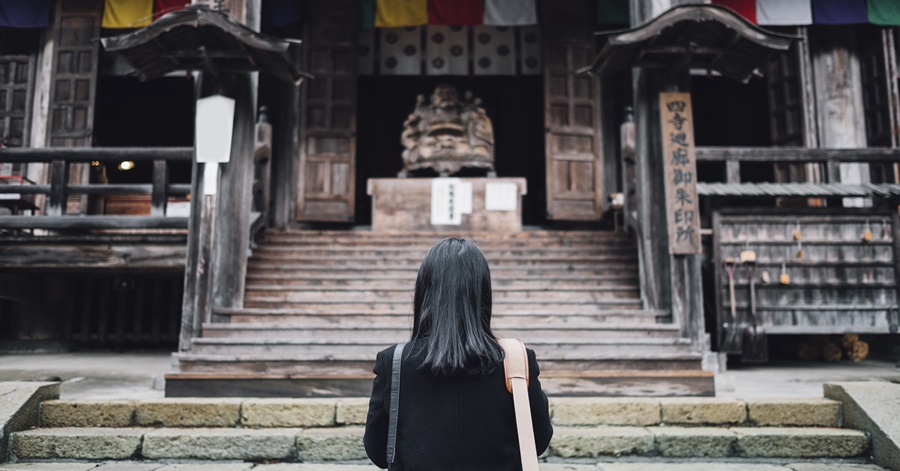Japan, as a predominantly conservative country, has different norms in many aspects of life, including dress code, than Western countries. Keep reading for some practical Japanese dress code recommendations for what to wear during life’s most significant situations if you don’t want to offend and want to be fashionably prepared.
This guide does not only apply to first-time tourists in Japan but even to those who plan to work and live here in the long run. If that’s you, then make sure to read until the end of this guide.
Japanese National Dress: How do Japanese Dress?
Japan exists in its own world, with its own set of values, priorities, and, as a result, regulations. Tourists visiting larger towns are easy to note the repetitious pattern of clothing worn by the Japanese population due to the conforming society. Salarymen in nearly identical outfits, modest business ladies nicely presented without a single crease, and, of course, the slightly varying hues of brunette hairstyles in the crowd.
Although traditional Japanese clothing has largely been superseded by Western clothing, Japanese people still wear kimonos for special occasions, and there’s no reason why you shouldn’t, too.
Kimono
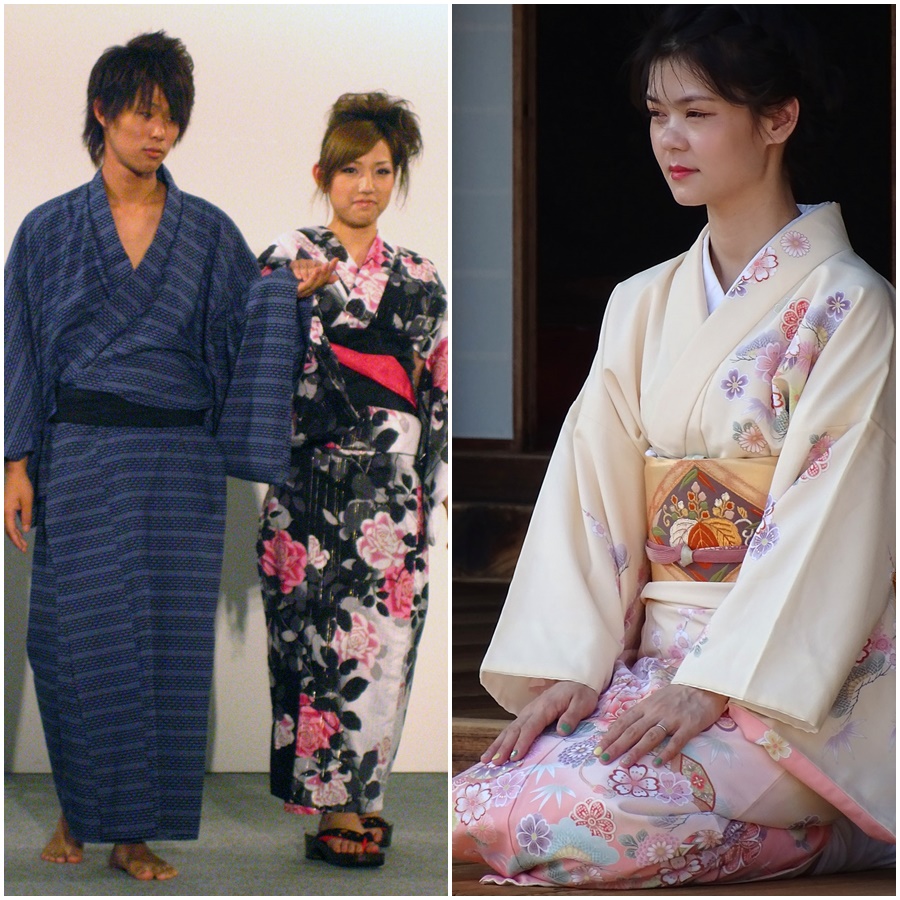
The kimono is the most well-known traditional attire for both men and women. It is typically worn during weddings, tea ceremonies, and other formal events. When celebrating Coming of Age Day, which occurs at the beginning of the year in which they turn 20, young women customarily wear a form of kimono called a furisode.
Yukata
In the summer, men and women wear yukata, a casual type of kimono made of cotton. Yukata are generally worn at festivals these days, but you may be given one if you stay in a traditional ryokan inn or visit an onsen hot spring resort.
Hakama
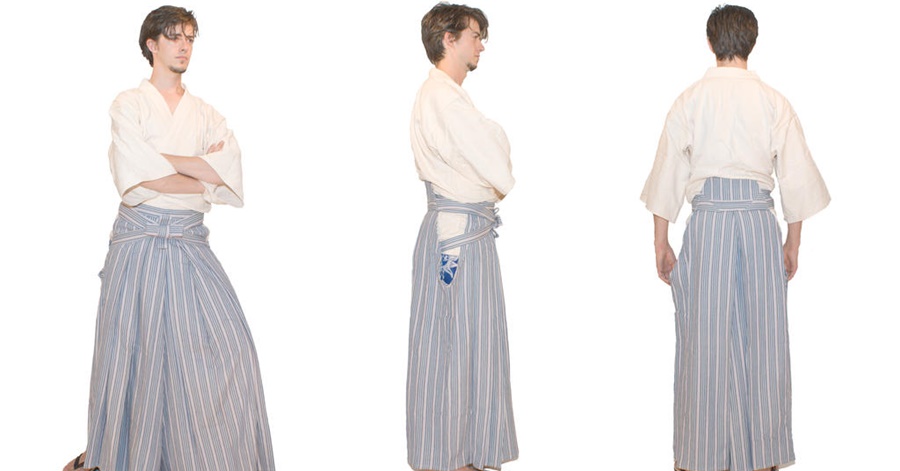
The hakama is the traditional formal dress for men. It can be a pleated skirt or full-cut trousers worn over the top of a standard kimono for formal occasions such as weddings, as well as for martial arts.
Tabi
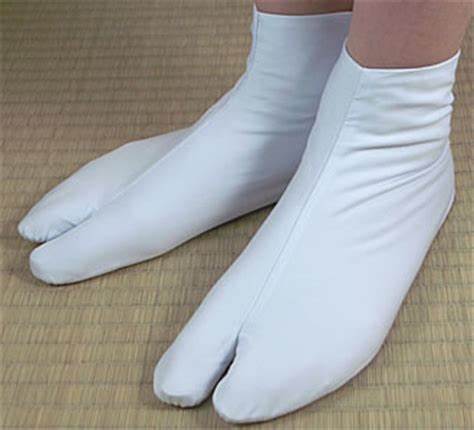
Tabi socks are also an important feature of traditional attire. They are white and made of cotton, and they separate the big toe; after wearing them for a while, you will see that they are really comfortable. Because of the separation between the big toe and the rest of the toes, they can be worn with traditional sandals called zori and geta.
Dress Code in Japan for Tourists
Since the weather can be quite extreme here in Japan, you’d be okay to be seen in a T-shirt and shorts and sneakers. While most of the locals, especially older men, prefer wearing pants and shirts, there is no hard rule that tourists should, too. Again, if your goal is to explore and walk around through the busy streets of the city or hike up the more serene nature scenes in the country, then make sure to wear appropriate clothing.
For women, outfits mustn’t be too revealing (no shoulders, chest, or too much legs). So a regular T-shirt and comfy jeans would be perfect, especially for a walk, maybe at the park or the city on regular days.
Business Dress Code in Japan
Although Japan is famed for its colourful, intriguing, and one-of-a-kind sense of fashion, which originated on the dynamic street of Harajuku, you will be hard-pressed to locate any splash of colour in the streets during the typical workweek.
Japan has a communal culture in which it is critical to fit in. While a suit can vary in colour and design in Western countries, it is necessary to stick to black or navy with a neutral shirt and tie in Japan.
It is also necessary to remain clean from head to toe. Japanese males keep their hair short and properly styled, while businesswomen avoid heavy makeup and perfume. Shoes should be clean and, ideally, easy to remove. Make certain that your socks do not have any holes in them.
Despite the fact that Japanese business dress is typically modest, a high-quality suit will be noticed. It is critical to remember that the tidy, black suit is code for respect.
Japan Dress Code for Men

Most of the time, you’d see men here in Japan on the streets after work hours or on their way to work. For a typical salaryman or someone who works 9 to 5 in the office, you’d find them wearing a business suit. But if you’d like to know the specifics of what you can and couldn’t wear here on a daily basis, consider the following pointers:
- Suit of a dark, solid colour such as black, navy, or dark grey. Wear no pinstripes or other unusual patterns. When in doubt, purchasing a “recruit suit” may be beneficial when job hunting in Japan.
- Underneath your coat must be a white shirt. A very close-to-white light shirt may be acceptable depending on the organization, however many employers prefer new graduates to wear white shirts.
- Conservative tie – striped, dotted, or plain. The majority of interviewers prefer anything in the blue or red colour family.
- Wear dress shoes in black or dark brown colors.
- The belt you wear should be the same colour as the shoes.
- Also, the socks must be in dark colors.
- Accessorize with a modest dress watch and, if applicable, a wedding band.
- Carry a briefcase in black or dark color. Check that it fits an A4 folder. (Be sure to bring extra copies of your resume!)
Japan Dress Code for Women
Wearing short shorts or skirts, especially the shortest of shorts, is perfectly acceptable when it comes to ladies, but wearing anything with spaghetti straps or a showing chest area is deemed highly unacceptable. Tank tops are considered undergarments in this country, so cover yourself if you want to blend in.
On some days, however, the desire for comfort trumps the concept of jeans or any type of limited clothes. Unfortunately, wearing tracksuit bottoms or leggings outside of the gym is frowned upon and considered a sign of laziness here in Japan.
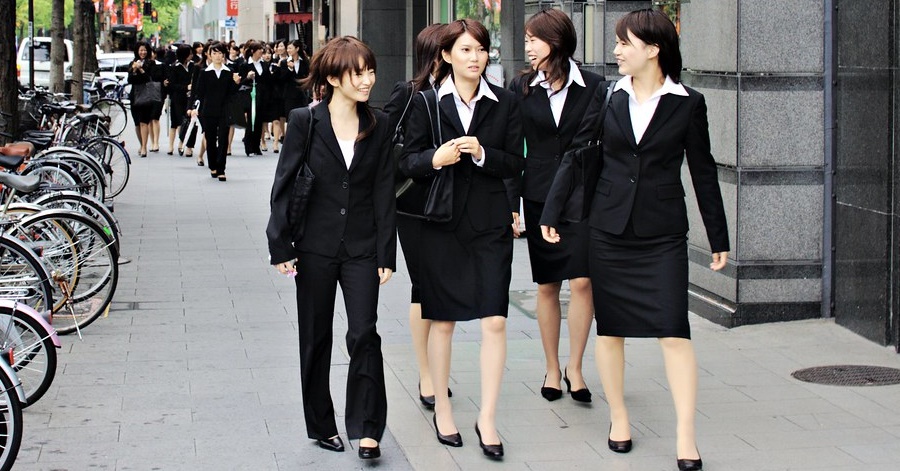
At work, women are also expected to look formal and subtle, usually, in the same colors as the men. Here are some of the things to consider when choosing what clothes to wear to work for the ladies:
- Suit with a dark, solid skirt in black, navy, or dark grey. Pants suits are also appropriate, however, skirt suits are preferred in more conservative settings. Check that your skirt is not too short or overly tight. When in doubt, purchasing a “recruit suit” may be beneficial when job looking in Japan.
- Wear a plain white blouse underneath your cardigan or office blazer.
- Complete the look with court shoes in black or navy colors, with 5cm-7cm heels. Don’t wear any open-toed shoes, sandals, platforms, or clogs.
- Accessorize with a modest dress watch and, if applicable, a wedding band. Simple necklaces or little stud earrings may suffice.
- Wear nude, sheer tights.
Japan Temple Dress Code
Temples do not have a dress code. However, for males, tidy casual wear — collared shirts (may be polo or golf shirts) and trousers – is preferred. Women should wear a modest top and pants or a longish skirt. Nice socks are also a must for when you have to remove your shoes in temples and restaurants.
Tokyo Dress Code
Temperature is one of the many (if not the main) factor to consider when choosing what to wear in Tokyo or any city for that matter, here in Japan. With this in mind, here’s a brief guide on what the temperatures are like throughout the year in Japan:
- August is the Hottest Month in Japan
Just to prep you for the worst: On average, August is the warmest month of the year, especially in the afternoons. Because it is humid and hot in the morning, it is recommended to wear something light, such as summer dresses, t-shirts, and shorts. When possible, limit outside activities to the morning and evening.
- Low Temperatures Start in December and January
The coldest season in Tokyo begins in mid-December, with temperatures sometimes falling below 1.8°C (35.1°F) in the morning. Because the average temperature dips below 10°C (50°F) from November to March, you should pack a decent winter jacket and warm shoes.
- From January to March: Keep Yourself Warm
As previously stated, the temperature tends to remain below 10°C (50°F) from January through March. It can even get below 0°C (32°F) at times, so you’ll need a thick coat at the very least to remain warm! If you’re feeling really cold, you might always show off your fashionable side by wearing a gorgeous scarf, knit cap, or even mittens as accessories.
- April through June: The Most Comfortable Months
From April to May, the weather in Tokyo is generally pleasant, with average daily temperatures reaching around 20°C (68°F). In April, however, the difference between the morning low and the daytime high is greater. Because it will be cold in the morning and evening, you should bring a small jacket or hoodie just in case. In Tokyo, the months of May and June are often the warmest.
- From July to September: Hot and Humid Summer
The morning low in July and August is often just below 30°C (86°F), implying that temperatures will be above 30°C every day. Dress in shirt sleeves, skirts, shorts, or dresses. There are a lot of fireworks celebrations in Tokyo this time of year, so you’ll see a lot of people dressed in the Japanese casual kimono known as yukata. If you have the opportunity, you should try it!
- October to December: Temperatures Drop!
Between October and December, the average daytime high is 23°C (73.4°F), while the morning low is 17°C (62.5°F). Fall is a great time to visit Japan because the weather is once again pleasant and there are beautiful vivid red and yellow leaves everywhere.
Even while Kyoto is the most well-known destination for momiji (red maple leaves), you may find wonderfully colored leaves all across Japan, including Tokyo’s gardens and parks. You might need to bring a light jacket or sweater with you.
Japan, despite what most people think, has become much more modern when it comes to clothing. However, people here have strict and deep cultural ties. And with that said, some form of tradition and codes are observed for certain occasions and events. Now that you’ve reached this part of the guide, you will have a better idea of what you should wear when visiting (more so when moving) here in Japan. Keep this guide handy and you’ll be fine adjusting to how people look and plan their wardrobe in this country!
READ NEXT: What You Need to Know About Work Culture in Japan

